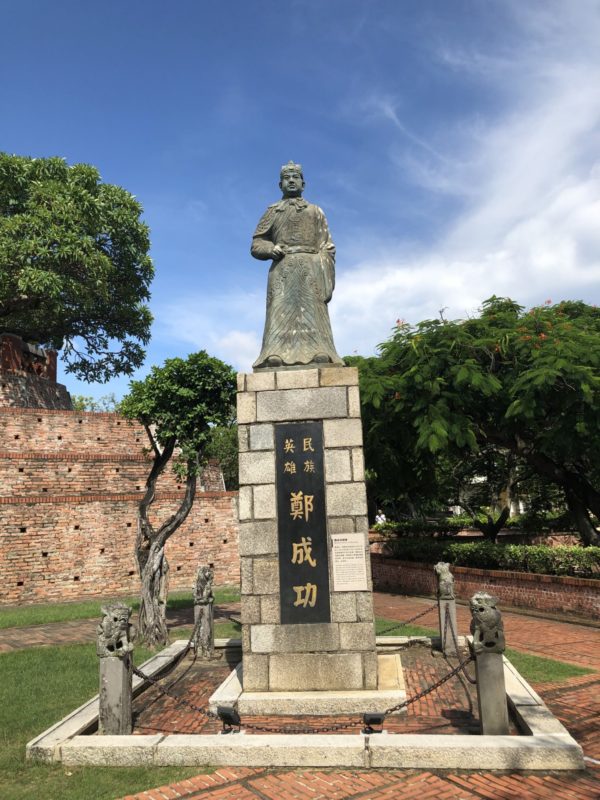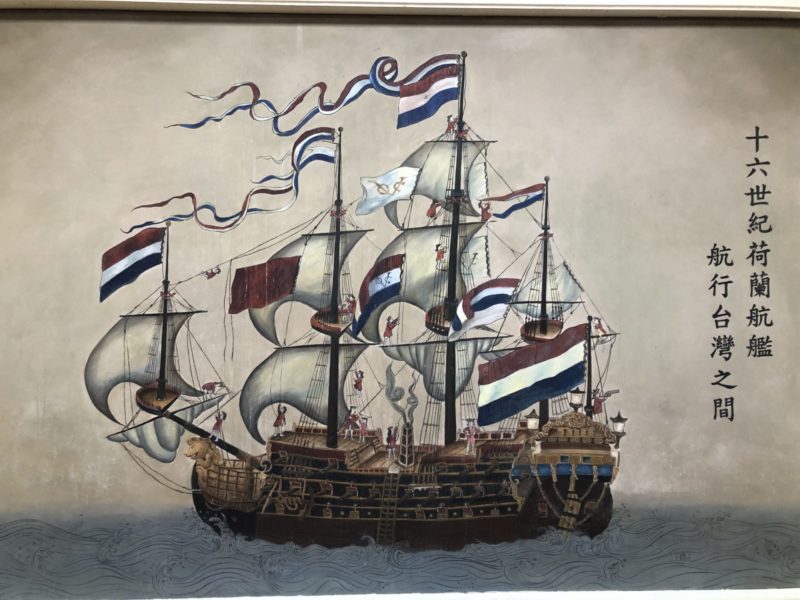
Statue of Koxinga at the ruins of Fort Zeelandia in Tainan, Taiwan.
In the early 1600s, Dutch ships sailed into the Bay of Toayuan not far from the Portuguese outpost in Macao and in a prime location at the intersection of Chinese and Japanese shipping lanes. Eventually, the bay gave its name to the entire island—Taiwan—but at the time, it served as an ideal harbor in which the Dutch could build a new stronghold—Fort Zeelandia. At the height of their Golden Age, the Dutch Empire continued to incorporate new lands like Taiwan into its ever-expanding imperial grasp. By the mid-seventeenth century, the Dutch Empire boasted colonial holdings throughout Asia, Africa, North and South America. By the end of the century, Dutch Brazil had fallen to the Portuguese, the English had seized New Netherland, and Chinese immigrants led by the Xiamen-based captain Koxinga had wrested control from their imperial overlords in Taiwan. In the wake of these territorial losses, the Dutch shored up an imperial network that persisted for centuries.[1]
Even at the height of their imperial powers, the Dutch did not necessarily attempt to fill settlements throughout the world with Dutch immigrants. As world historian Kerry Ward has noted, Dutch colonization under the East India Company did not always pursue exclusive territorial holdings.[2] In Taiwan, for instance, Dutch officials kept the island’s indigenous population at bay and their storehouses full by ferrying scores of Chinese immigrants across the Taiwan Strait.[3]
For centuries, the Dutch were unquestionably imperialists. Economic outposts constituted the primary hubs in the global networks that shaped the Dutch Empire. To better understand the complexity of this model of empire building, Ward argues that studies of empire, and the Dutch Empire in particular, should rely on analysis based on networks and the multilevel relationships among nodes within the imperial web. Within this framework, Ward identifies ten overlapping networks: bureaucracy, correspondence, trade, transportation, migration, law, administration, information, diplomacy, and culture.[4] Regional centers within broader imperial webs often served as hubs for these interchanges. The Dutch Empire was not just about Amsterdam and The Hague but also included its outposts in the Southeast Asia, South Africa, South America, and maybe even the American Midwest.

Dutch Ideas of Empire in the American Midwest
In the 1840s, thousands of Dutch men and women pulled their wagons into the prairies and forests of the American Midwest. They came as immigrants, but they also intended to set up Dutch colonies in the United States. They used unabashed language of colonialism and empire building, not totally dissimilar from the language of seventeenth-century Dutch imperialists. These new immigrations intended to move into “uninhabited land,” build “colonies,” sustain many elements of their Dutch culture, and continue to cultivate robust religious, familial, and economic connections with the Netherlands. Could this be viewed as a potential Dutch imperial extension into the Midwest?
Admittedly, what follows is not a fully developed argument, but more so, for me at least, a way of asking a different kind of question about the intersection of immigrant communities, the Midwest, and global imperialism. How might re-framing histories of European immigration to the Midwest, and Dutch immigration in particular, in light of Dutch ideas of global empire lead to new questions and insights about the history of settlement on the U.S. frontier?
If we use Ward’s networks for analysis, tracing how some networks persisted across national boundaries is easier than others. For instance, the correspondence, trade, and culture of these Dutch colonies remained closely connected to their homeland. Exploring how bureaucracy, law, and administration managed to transcend national boundaries, however, initially appears more difficult. In the remainder of this post, though, I want to suggest three possible ways that these networks also crossed borders in a way that maintained, at least initially, the trappings of the Dutch Empire.
The Dutch migration to the Midwest was not a pell-mell movement of desperate people, but an organized and coordinated bureaucracy connected people across the Atlantic and put in place a structured community once immigrants arrived in the United States. For instance, Henry Scholte founded the colony in Pella, Iowa in 1847 and led The Netherlandish Association for Emigration to the United States of North America, which served to select prospective immigrants and aid in their transition to the U.S.[5] They also relied on a developed hierarchy of ecclesial bodies to govern and oversee their churches in the United States.[6] Some men served as deacons, aiding those in need. One rung higher in authority, elders oversaw the cultural and spiritual health of these new communities, and the clergymen sat atop this bureaucratic organization. These men not only coordinated transatlantic journeys and oversaw church life, but they also negotiated land purchases, mediated disputes, and defended their community in print and occasionally in court. There was already an independent Dutch bureaucracy in place from the moment the Dutch immigrants set foot on the first ship destined to cross the Atlantic.
When Dutch immigrants relocated to the Midwest, they understood that they were now under the jurisdiction of the United States; however, in matters of church law, they maintained their independence. Because the communities they established often had close ties to their ecclesial leadership, unwritten social norms and church law held force. Many of the associations that facilitated the immigration even included strict guidelines about the religious and moral lives of potential immigrants. In early settlements, immigrants with complaints went before the church board. When a widow lodged a grievance with her church council after being the victim of a harsh settlement following her husband’s death, these officials looked to Dutch rather than American precedent to decide her case.[7] When a local newspaper editor ran an editorial speaking harshly of a prominent pastor in town, the community could not infringe on his right to free speech, but the church council cut him off from all church sacraments, effectively casting him out of the church until he made amends.[8] Dutch ecclesial law could be administered in the United States at the hands of Dutch immigrants even if they fell under the broader authority of U.S. law and officials.
Of these layers of the imperial networks, I would argue that Dutch influence exercised the greatest control in the administration of these Dutch colonies in the United States. In the 1840s, most Dutch clergy in the Midwest came from the Netherlands, and Dutch Reformed churches stayed closely connected to their Dutch traditions. Dutch officials, often the clergymen themselves, shrewdly worked their way into government positions in the U.S. and quickly organized civic life in a way that favored their Dutch settlements. Local public schools, county boards of supervisors, and other offices ranging from the justice of the peace and the notary public to representatives to the U.S. House of Representatives quickly fell into Dutch hands. When viewed at a national or regional level, these immigrant settlements were administered by U.S. officials; however, locally, they were administered entirely by Dutchmen, many of whom arguably maintained stronger ties to the Netherlands than their new homeland.
If we adopt an understanding of imperialism that reflects Dutch ideas of empire as outlined by Ward, might that change how we view the arrival of European immigrants on the frontier? Furthermore, how does the application of Dutch ideas about imperialism recast the language of Dutch colony building, cultural maintenance, and continued ties to the homeland in the American Midwest?
To be clear, the nineteenth-century Dutch government had no ambitions of gaining sovereignty over the eastern coasts of Lake Michigan or on the plains of Iowa—the primary areas settled by Dutch immigrants. However, the Dutch model of imperialism is one that did not always demand absolute sovereignty. Even in the more territorially driven British model, Kristin Hoganson contends that nineteenth-century “emigration [to the Midwest]… would not necessarily mean a break from England. It could be a way to nourish it.”[9] Historically, when the Dutch lost colonies, as occurred in the Dutch colonial holdings in New York and New Jersey or South Africa, language, religion, and trade kept communities linked to the Netherlands. The Dutch could reap the benefits of empire, in many cases, without having to be sovereign over a territory. Was the constellation of Dutch settlements throughout the Midwest just another example of nineteenth-century immigration or within a Dutch understanding of imperialism, might it have been a little empire on the prairie?
[1] Tonio Andrade, How Taiwan Became Chinese: Dutch, Spanish, and Han Colonization in the Seventeenth Century (New York: Columbia University Press, 2008), 42.
[2] Kerry Ward, Networks of Empire: Forced Migration in the Dutch East India Company (Cambridge: Cambridge University Press, 2009), 62.
[5] Nederlandsche Vereeniging ter Verhuizing naar de Vereenigde Staten van Noord-Amerika, Henry S. Lucas Papers, 1846-1930, Reel 3, Bentley Historical Library, the University of Michigan, Ann Arbor, MI.
[6] Hans Krabbendam, Freedom on the Horizon: Dutch Immigration to America, 1840-1940 (Grand Rapids: Eerdmans, 2009), 99-100, 231, 299-300.
[7] Minutes of First Reformed Church, Holland, Michigan, October 3, 1853. Hope College, “H97-1301. Michigan, Holland. Pillar Church. Records, 1847-2003, Box 1,” Joint Archives of Holland, Hope College.
[9] Kristin Hoganson, The Heartland: An American History (New York: Penguin Press, 2019), 105.

One Thought on this Post
S-USIH Comment Policy
We ask that those who participate in the discussions generated in the Comments section do so with the same decorum as they would in any other academic setting or context. Since the USIH bloggers write under our real names, we would prefer that our commenters also identify themselves by their real name. As our primary goal is to stimulate and engage in fruitful and productive discussion, ad hominem attacks (personal or professional), unnecessary insults, and/or mean-spiritedness have no place in the USIH Blog’s Comments section. Therefore, we reserve the right to remove any comments that contain any of the above and/or are not intended to further the discussion of the topic of the post. We welcome suggestions for corrections to any of our posts. As the official blog of the Society of US Intellectual History, we hope to foster a diverse community of scholars and readers who engage with one another in discussions of US intellectual history, broadly understood.
Andrew, I really enjoyed this post, for so many reasons. The kicker is great, of course — but so is the discussion in between. Was just teaching today about Samuel F.B. Morse and the nativist politics of the antebellum era, the anti-Catholic rhetoric and panic about minions of the Pope taking charge of the political system to enact a “Roman” politics, etc. I’d be really interested to know if this “friendly takeover” by Dutch immigrants was viewed with great suspicion, and by whom.
The post also reminded me, more generally, of the perils of teaching US history as anything other than just a part of the history of the Atlantic world. The methodological/pedagogical question for me is this: when/how (or whether?) to narrow the focus to “the national.” I spend the first several weeks of the survey in “transatlantic history” mode, but I do end up shifting gears during the antebellum era. Maybe I should never shift gears at all. That would, I think, require a “U.S. and the world” approach. I’m open to it, but have never actually tried it.
Suggestions welcome.